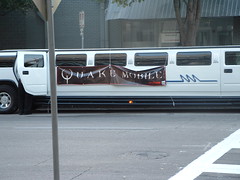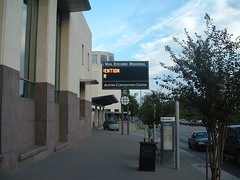 I attended the 2005 Austin Game Conference this past weekend. As I am in my final year of graduate school (until I eventually go back for a Ph.D), it has become time for me to start attending the job conferences and expos for the industry that I wish to enter. This was the first such conference I have gone to, and it was quite a revealing experience. Much of what I had thought to be true was confirmed, and I also learned some new things and got some ideas for future reference.
I attended the 2005 Austin Game Conference this past weekend. As I am in my final year of graduate school (until I eventually go back for a Ph.D), it has become time for me to start attending the job conferences and expos for the industry that I wish to enter. This was the first such conference I have gone to, and it was quite a revealing experience. Much of what I had thought to be true was confirmed, and I also learned some new things and got some ideas for future reference.
I stayed at the Radisson on E. Cesar Chavez Ave., right in the heart of downtown Austin (and a direct 3 block walk down the street from the convention center where the conference was held). My 12th floor room had a view overlooking the Colorado River, and was right by the famous Congress Bridge which is the home to the largest bat colony in North America. I didn’t get a chance to see the bats, but someday soon I’ll be back. 
The conference began with a keynote speech by Sony Online Entertainment (SOE) President John Smedley. Smedley offered his vision of online games in the future:
(Abridged and paraphrased): A kid walks into a Starbuck’s with his PSP. He turns it on and gets online in Untold Legends. No configuration hassle, the device just linked up to the T-Mobile hotspot and began. The kid plays with some net friends - but these friends are kids in Tokyo riding a train, playing the same game on their cell phones with GeForce2-level graphics chips (such phones are already on the market in Japan). Finally, the kid at Starbuck’s goes home, and fires up his PS3. There, he gets on the same game, with the same character, and can continue playing with his Tokyo cell phone playing friends. Obviously, the game looks different on the PS3 than on the PSP or cell phones, but the game remains consistant and universal.
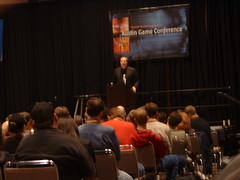 Along the way in explaining this vision, Smedley dropped the “Leeroy Jenkins” clip on us, as well as the “chocolate milk kid” clip, as examples of how player behavior poses a challenge in the development of these games (as Smedley said, having an ogre in EverQuest with the screaming kid’s voice coming out of it would be incredibly distracting). He termed the challenge as “solving the ‘idiot’ problem”.
Along the way in explaining this vision, Smedley dropped the “Leeroy Jenkins” clip on us, as well as the “chocolate milk kid” clip, as examples of how player behavior poses a challenge in the development of these games (as Smedley said, having an ogre in EverQuest with the screaming kid’s voice coming out of it would be incredibly distracting). He termed the challenge as “solving the ‘idiot’ problem”.
Smedley also had some interesting things to say about the upcoming console generation. When it comes to storage, Smedley said, “Guess what? Hard drives are optional on the next generation of consoles too. That doesn’t make our job any easier, but we adapt.” He offered some alternatives to hard drive storage, such as networked storage and streamable content. “We hope we can get people to buy the hard drive kits on the next gen consoles, but we’re not relying on it.”
He finished his keynote with some thoughts on the business model of MMO games. Subscription costs have not gone over well in the console world. Alternative solutions, however, have something to offer. He first talked about the contraversial topic of item sales for MMO games. He spoke of Station Exchange, an auction service by SOE for EverQuest 2. He said that 33% of EQ2 players are signed up for the service, and that the “secondary market” that Station Exchange is a big part of pulls down $300-$500 million a year. What was once something that was banned and shunned has instead been embraced and turned into a proft stream. (That last sentence is my editorializing - Smedley left out the part about SOE’s initial reaction to the “secondary market”).
Station Exchange is just an example of what Smedley called “added value services”. The idea is to make the game subscription free, but offer added value services to provide the income streams (beyond the initial game sale). He gave an example of a “velvet rope” bonus subscription for $5/month as something that could be offered.
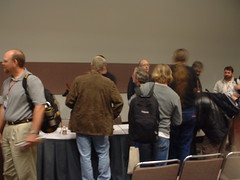 After the keynote was a break, and then the first round of seminars. I attended a seminar named “Relational Database Chices for MMOs”. The panel featured four developers from companies that produced some major MMOs, including City of Heroes and Dark Age of Camelot. They talked about where they use relational databases, and equally important, where they do not. I was surprised to hear just how much many of their games rely on “flat files” for a number of data storage purposes. The major issue with relational databases, they told us, is the delay between the request for information, and the successful retrieval and return of that info. The databases are too slow for looking up information on-demand in real-time gameplay. Players expect their button press to be followed with action instantaneously, not button press, then a heartbeat’s time, then action. In game elements where the instant response is not so important (such as an in-game auction house), then relational databases are an option. An interesting topic of conversation was the specific relational databases each company uses - two (including the devs for Dark Age of Camelot) use MySQL, while the other two (including the devs for City of Heroes) use Microsoft SQL. The guy from Mythic relayed a story about their inquiry on pricing for an Oracle database, which used to only be determined by number of users (which, for an MMO, is outrageously large). Oracle has since begun offering pricing per CPU, which makes it feasible for new MMO design now. One final note was something that the Mythic guy said about the industry’s need for DBAs (database administrators). He said he knew plenty of companies where a DBA could walk into HR and say, “I’m a DBA. Hire me.”, and HR would answer, “OK.”
After the keynote was a break, and then the first round of seminars. I attended a seminar named “Relational Database Chices for MMOs”. The panel featured four developers from companies that produced some major MMOs, including City of Heroes and Dark Age of Camelot. They talked about where they use relational databases, and equally important, where they do not. I was surprised to hear just how much many of their games rely on “flat files” for a number of data storage purposes. The major issue with relational databases, they told us, is the delay between the request for information, and the successful retrieval and return of that info. The databases are too slow for looking up information on-demand in real-time gameplay. Players expect their button press to be followed with action instantaneously, not button press, then a heartbeat’s time, then action. In game elements where the instant response is not so important (such as an in-game auction house), then relational databases are an option. An interesting topic of conversation was the specific relational databases each company uses - two (including the devs for Dark Age of Camelot) use MySQL, while the other two (including the devs for City of Heroes) use Microsoft SQL. The guy from Mythic relayed a story about their inquiry on pricing for an Oracle database, which used to only be determined by number of users (which, for an MMO, is outrageously large). Oracle has since begun offering pricing per CPU, which makes it feasible for new MMO design now. One final note was something that the Mythic guy said about the industry’s need for DBAs (database administrators). He said he knew plenty of companies where a DBA could walk into HR and say, “I’m a DBA. Hire me.”, and HR would answer, “OK.”
 At the end of that session was a lunch break. There was another round of sessions after lunch, but I sat that one out, as none of the lectures interested me, and I wanted a chance to roam the Tech Pavilion floor without the heavy traffic that exists in-between sessions. I got a chance to talk to some recruiters from a recruiting agency (“As soon as you finish that master’s, call us”), as well as to some guys from BioWare and Microsoft. Alas, the BioWare guy pointed out that Canada isn’t an option for me at this point due to visa laws (I have the requisite degree, but not the 2 years of industry work experience needed). The Microsoft guy asked for a copy of my resume and told me to be sure to hit up the recruiters that come to Fresno State.
At the end of that session was a lunch break. There was another round of sessions after lunch, but I sat that one out, as none of the lectures interested me, and I wanted a chance to roam the Tech Pavilion floor without the heavy traffic that exists in-between sessions. I got a chance to talk to some recruiters from a recruiting agency (“As soon as you finish that master’s, call us”), as well as to some guys from BioWare and Microsoft. Alas, the BioWare guy pointed out that Canada isn’t an option for me at this point due to visa laws (I have the requisite degree, but not the 2 years of industry work experience needed). The Microsoft guy asked for a copy of my resume and told me to be sure to hit up the recruiters that come to Fresno State.
Also at the Microsoft booth was an Xbox 360 kiosk. Let me tell you: that stuff you’ve been hearing about 360 games looking like “current gen” games? Hogwash. Granted, it’s not the monsterous leap forward that the current gen systems were from the hopelessly grainy and barely-able-to-do-3D systems like the old PSX, but the difference is obvious. All of the playable demos were running at a blazing 60 frames per second in 720p. You don’t see that in screenshots, but the difference it makes when seeing it in action is obvious. It’s silky smooth enough animation to confuse with reality, rather than just smooth enough to not be “choppy”. It’s about time. Having games that don’t dip down into choppiness during high action sequences is an important hurdle to get past in order to get closer to that ever-popular buzzword, “immersion”.
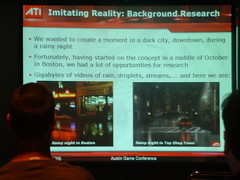 The next session I attended was ATI’s “Demo Team Secrets: The Next Generation”. The ATI guy showed their Toyshop Demo, and went over some of the techniques used to create the effects in the demo. The demo uses a technique called Parallax Occlusion Mapping, which was developed by one of the ATI engineers and was a topic of a good chunk of the session. The demo also highlighted DirectX9 HLSL, and some neat ideas for rendering rain in realtime cheaply. Hopefully, the presentation gets posted to their Tech Papers & Presentations section of their website soon.
The next session I attended was ATI’s “Demo Team Secrets: The Next Generation”. The ATI guy showed their Toyshop Demo, and went over some of the techniques used to create the effects in the demo. The demo uses a technique called Parallax Occlusion Mapping, which was developed by one of the ATI engineers and was a topic of a good chunk of the session. The demo also highlighted DirectX9 HLSL, and some neat ideas for rendering rain in realtime cheaply. Hopefully, the presentation gets posted to their Tech Papers & Presentations section of their website soon.
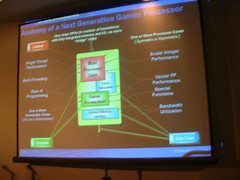 The final session I attended on day 1 was “IBM Processors and Technologies”, in which the topic of discussion was not the Cell processor, but rather the CPU used in the Xbox 360. A bunch of details on the processor was released within the past few days, so this presentation was pretty close to the debut of a lot of information. I’m not a hardware engineer, so this wasn’t all quite up my alley, but I did get something out of the session. One of the topics of discussion was the contraversial decision of using inorder execution (as opposed to out-of-order execution, which allows for the rearrangement of commands at the instruction level, in order to minimize pipeline stalls and such.) IBM made it clear that this was a customer requirement (as in, Microsoft, and Sony for the Cell). They also said that inorder execution permits more predictable performance for the processors, and that multi-threaded processors like these benefit less from out-of-order execution - instructions that would stall everything behind it on a single core chip can be executed on a different core, while the instructions behind it can execute on a different core.
The final session I attended on day 1 was “IBM Processors and Technologies”, in which the topic of discussion was not the Cell processor, but rather the CPU used in the Xbox 360. A bunch of details on the processor was released within the past few days, so this presentation was pretty close to the debut of a lot of information. I’m not a hardware engineer, so this wasn’t all quite up my alley, but I did get something out of the session. One of the topics of discussion was the contraversial decision of using inorder execution (as opposed to out-of-order execution, which allows for the rearrangement of commands at the instruction level, in order to minimize pipeline stalls and such.) IBM made it clear that this was a customer requirement (as in, Microsoft, and Sony for the Cell). They also said that inorder execution permits more predictable performance for the processors, and that multi-threaded processors like these benefit less from out-of-order execution - instructions that would stall everything behind it on a single core chip can be executed on a different core, while the instructions behind it can execute on a different core.
After the conference ended, it was time to hit the streets of Austin. Though, without any vehicle transportation, I wasn’t really going far. But I did enjoy some sights on the way back to the hotel:
Austin is truly a beautiful city:

